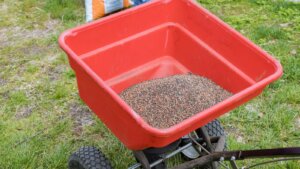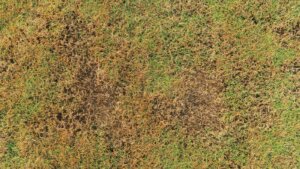Is your lawn looking a little brown, a little dry? Sometimes, your lawn grass needs a little help in the form of proper fertilization. There are lots of different types of fertilizer, each of which may lead to a great result – when they are used correctly.
Applying sulfur could be a fantastic way to make your lawn look lush and green, but it’s also important to know how often you can apply sulfur. Incorrect application could even lead to burned grass! Here’s everything you need to know about soil pH level and how sulfur might be able to help.
Soil pH level
The soil of a lawn should ideally be between 5.5 and 7.0, which is a range considered slightly acidic to neutral. However, most urban lawns have a pH level of over 7.0, more alkaline than soil that is nearby and native.
This unnatural phenomenon is caused by urban development, which scrapes away the rich topsoil, leaving behind the more alkaline subsoil. This could be problematic for the health of your grass, though it is often not avoidable.
Another issue that occurs is when cement is put around a building (sidewalks, driveways, etc.). This cement presence will result in lime leaching, where excess water flows through the cementitious material. Over time, this makes the soil pH alkaline.
Sometimes, municipal water sources also raise the soil pH with their concentration of bicarbonates.
With so many factors influencing the soil pH level, you’ll find that your lawn soil is probably alkaline. So how does the pH level affect the question of: How often can I apply sulfur to my lawn? Let’s dive right in.
What does sulfur do to an alkaline lawn?
Grass that is deficient in sulfur often looks yellow, with stunted growth and an unaesthetic appearance. It will also be weaker, especially when facing problems like drought and disease.
If the grass has sufficient sulfur, then it will look healthy, dense, and green. Because it is healthier and stronger, it is often less susceptible to disease and can tolerate changing weather conditions throughout the seasons better. It will become sturdier and more likely to survive fungal infections and drought.
Correcting pH with sulfur
Naturally, the solution that comes to mind is to apply sulfur and fix this stunted growth. However, the process of sulfur correction could take a long time, even years, before the soil will be properly amended.
Sulfur can be found in fertilizers in different forms: common ones include ammonium sulfate, gypsum, and ferrous sulfate.
How do I apply sulfur to soil?
The easiest way to apply sulfur is to sprinkle it on the lawn before you water the grass a good twenty minutes or so later. However, there are numerous factors to consider so that you don’t accidentally burn the grass. It’s also a good idea to wear gloves.
While sulfur can have amazing effects on the healthy growth of your lawn, turning your grass green and resilient, it may take some time before the effects become visible.
What to consider when applying sulfur to your lawn
Texture of the soil
Typically, the texture of the soil will indicate how much sulfur you should apply.
If your soil is sandy and alkaline, you can lower the alkalinity by applying around 10 to 15 pounds of sulfur per 1,000 square feet. Meanwhile, if the soil is of a clay-like consistency, you might have to put in 20 to 25 pounds of sulfur fertilizer before you see any effects.
How much sulfur to lower pH in lawn
Too much sulfur can actually cause burn damage to the grass, which would not be ideal. When applying sulfur, it’s important to do so gradually. A method that may work for you is to apply appropriate sulfur every 3 to 4 weeks, but depending on your soil, it might only be advisable to apply sulfur twice a year.
The best seasons to apply this amount of sulfur would likely be during the cooler, more mellow months of the year. Cooler fall and spring are good times.
The pH of your soil
It is also important to first test your soil to see that it is indeed alkaline. When testing the soil, you can either get an at-home testing kit or consult professional services for improved accuracy.
The sooner and more accurately you perform the soil pH test, the better idea you will have of how to apply sulfur to your lawn soil.
Knowing the pH of your soil enables you to find out how much sulfur you need to add in order to lower the pH to your desired level.
Applying sulfur for lawn that is not established
Of course, if your lawn is already established, this would not apply. But if you haven’t established it yet, you might want to consider incorporating your sulfur into the soil before you even do any seeding. You won’t have to worry about potentially burning the grass with excessive sulfur application.
The weather
Some weather and seasonal conditions can make it harder for you to apply fertilizer, though it is usually fine. If you find the air especially humid or hot, it’s probably a good idea to wait it out and apply the sulfur fertilizer some other time.
Another factor to consider is the wind. If it’s a very windy day, it can disrupt your precision, so waiting for another day to apply the sulfur may be worth it.
The presence of fruit trees
The presence of certain sensitive fruit trees such as apricot, apple, and pear may mean you should be careful when applying sulfur to the soil. If you grow fruit trees, it’s always advisable to research whether sulfur fertilizer will interfere with the production or preservation of fruit trees.
How do I ensure my lawn is healthy?
Fertilizers are a wonderful way to fix the sulfur deficiency of your grass.
Here at Terra Lawn Care, our specialists are devoted to keeping your lawn healthy and lush. Our fertilizers are best quality in the industry, and our technicians are individually certified and state licensed. Check out Terra fertilizer now!



